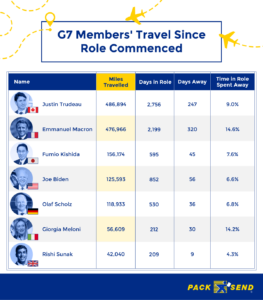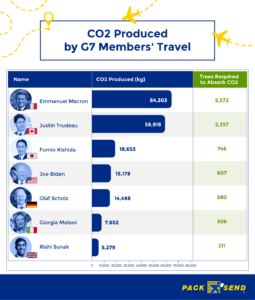
News
 Back to news
Back to newsUpdated 2023: Study Reveals the Mileage and CO2 Emissions from G7 Leaders’ International Travel
Thursday, 11 May 2023World leaders will soon be travelling to Japan for the G7 summit, this year happening between May 19th and 21st, to discuss various critical issues including climate change.
Ahead of this, PACK & SEND have repeated our study first carried out in 2022 that identifies which G7 leaders have travelled the most internationally since coming into power. This relaunch means we can reveal who has travelled the most since the last G7, held between June 26th and 28th 2022, and whose travel for administrative duties has generated the most CO2 emissions over time.
Collectively, the G7 leaders have travelled over 1.4 million miles internationally while in office. This is equivalent to travelling to the moon and back approximately three times.
Canadian Prime Minister Justin Trudeau takes the top spot for most miles travelled internationally with 486,894. Trudeau has been in office for the longest time period of all the current G7 leaders (2,756 days, or around 7.5 years) and has spent nine percent of this time on international trips for administrative purposes.

The second most-travelled G7 leader is French President Emmanuel Macron. Our research indicates he’s travelled 476,966 miles by plane for administrative duties.
Japan’s prime minister, Fumio Kishida, travelled the third-highest number of miles internationally with 156,174 miles worth of trips under his belt.
Joe Biden (125,593), Olaf Scholz of Germany (118,933), and Giorgia Meloni of Italy (56,609) take spots four to six for most air miles travelled when undertaking international duties whilst in office.
The final member attending this year’s G7 is the UK’s latest prime minister, Rishi Sunak. Taking up office in October 2022, Sunak will have spent just 209 days in the role when he arrives in Hiroshima for the summit. The PM has travelled 42,040 miles internationally over the last seven months, despite being away for just nine days, which works out as around 4.3% of his total time in office.
French President Emmanuel Macon and Italian Prime Minister Giorgia Meloni have both spent a far greater percentage of their time in office travelling internationally. In fact, Macron has spent 14.6 percent of his time away while Meloni has spent 14.2 percent of her time abroad for administrative duties.
As part of our research, we also analysed how much CO2 each leader generated due to their air mileage and how many trees would be required to absorb it.
Despite Justin Trudeau travelling the most miles, it was Emmanuel Macron who produced the most CO2 from his travel and spent the most days away. This indicates he took more trips than Trudeau but they were over shorter distances.
Over the years, Macron’s international travel has produced a staggering 64,303 Kg of CO2 during his years in office. To absorb this, 2,572 trees would need to be planted.

Justin Trudeau follows closely in second place with 58, 918 Kg of CO2 produced, resulting in 2,357 trees needing to be planted to cancel out the emissions created from his international travel.
By relaunching this study in 2023, we can highlight which leaders have produced the most CO2 over the last year.
Olaf Scholtz has had the most dramatic increase in travel this year. Between the start of his term and last year’s G7 Summit, Scholtz produced 3,642 Kg of CO2 from international travel. However, since then he has travelled significantly more miles, subsequently emitting 10,846 Kg between the two summits.
Joe Biden and Fumio Kishida have also had a dramatic increase in travel in the past year. Biden’s travel created 6,037 Kg of CO2 from the beginning of his term in 2020 to the G7 Summit last year. However, since then his travel has created 9,141 Kg. And Kishida’s travel had accumulated 8,022 Kg of CO2 since the beginning of his term in 2021 up until the G7 Summit last year. Since then, his travel has created 10,631 Kg.
As Rishi Sunak was not UK prime minister in June last year, we are unable to make a comparison for him. However, the increases in travel recently for other longer-term G7 members could be due to the inability to travel during much of the Covid-19 pandemic, leading to increased travel for events and discussions in its wake.
Methodology
This project focuses specifically on the Heads of State and/or Government that are members of the G7 and attending the G7-Summit 2023.
PACK & SEND collected a list of the international trips undertaken by each member since starting their role, up to and including travel to the G7-Summit 2023. Data was collected on 28th April 2023, so any planned trips between this date and the G7 were speculatively included.
Where members visited multiple places within one country on a single trip, domestic travel was not recorded, and the first place listed was used to identify an airport. When assigning an airport to each location, PACK & SEND used the nearest or most prominent airport. Trips for leisure purposes and those with ambiguous dates were excluded.
Where trips end and begin on consecutive days, the destination of the first trip was used as the starting location for the second trip due to the assumption that members had taken a shorter overnight flight rather than travelling to their home country again. For example, where a European member is in Africa on Day 1 and a different place in Africa on Day 2, PACK & SEND assume they did not travel back to Europe in between.
Where members travelled to more than one country in one day, for example visiting both France and Germany, this was counted as one day away.
PACK & SEND used the Air Miles Calculator to work out the number of miles travelled and kg of C02 produced by each member.
To work out the number of days each member has spent in their role up to and including the final date of the G7-Summit, PACK & SEND used the Date-to-Date Calculator. For the time in role spent away, the number of days away were divided by number of days in role and times by 100 to get a percentage.
The number of trees required to absorb the CO2 produced from each member’s travel was worked out by dividing the total CO2 by 25 (the number of kilograms of C02 the average trees absorbs each year according to EcoTree).
We acknowledge this analysis doesn’t consider private jets, nor does it know specific airports, flight routes, etc.
The full data and sources can be viewed here.
